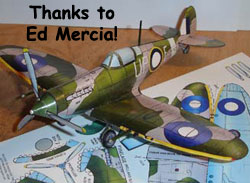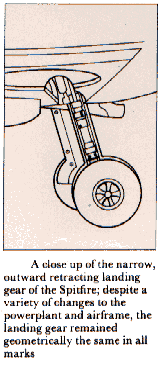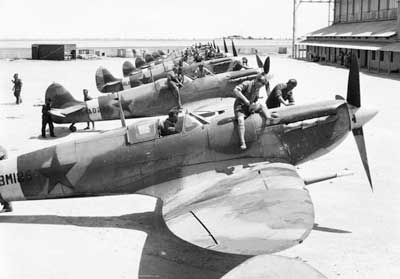
R.J.Mitchel creates the Supermarine Spitfire and wins WWII!
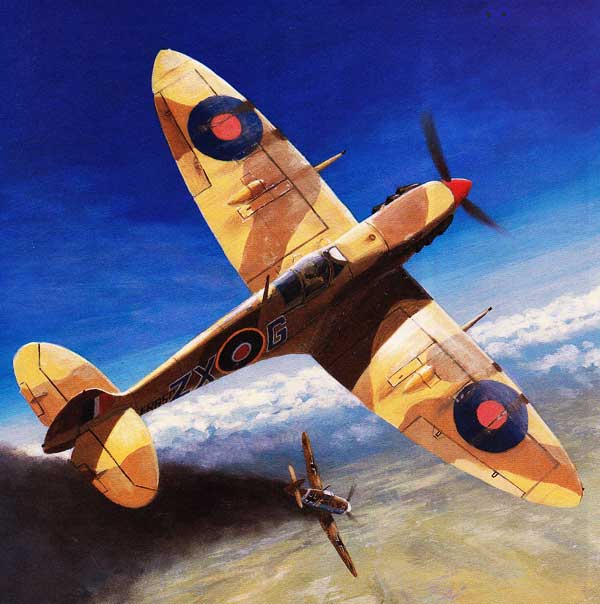
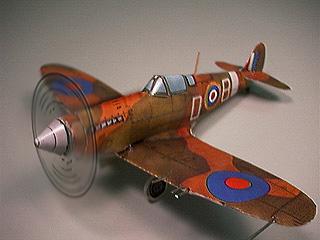
The name 'Spitfire' and 'Battle of Britain' go hand in hand. This British treasure was anything but a winner and is evidenced by the fact that with every new printing, it's always been the model to sell completely out.
The Brits (love ya mates!) can't get enough of them! :-) Lately, aviation enthusiasts have been busy reproducing Spitfires- an endeavor well worth the time!
To the British, the Spitfire was more than an airplane; it was a symbol. After the fall of France, when Britain stood alone and Germany was poised to launch a massive invasion across the English Channel, Britain's only protection seemed to be a handful of Spitfires and their incredibly brave pilots.
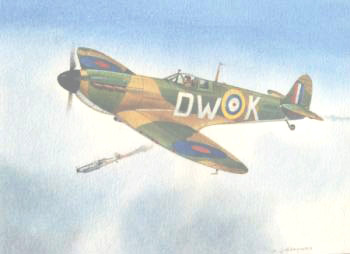 This was quite untrue, because at that time Fighter Command had many more Hawker Hurricanes in service than Spitfires, and they performed just as well as their more illustrious counterparts. But...
This was quite untrue, because at that time Fighter Command had many more Hawker Hurricanes in service than Spitfires, and they performed just as well as their more illustrious counterparts. But...
Supermarine Spitfire
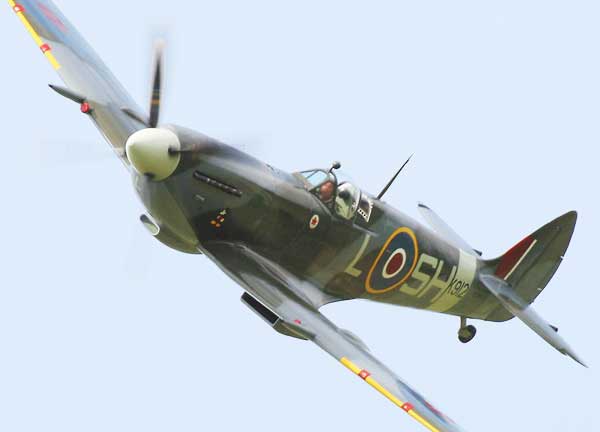
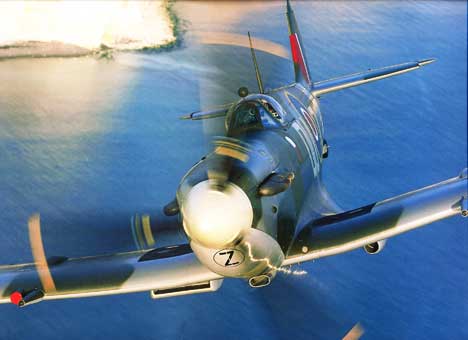 That said,
the Spitfire proved to have far more potential for development. It
was perhaps the finest fighting aeroplane of World War II, if not
of all time.
That said,
the Spitfire proved to have far more potential for development. It
was perhaps the finest fighting aeroplane of World War II, if not
of all time.
So much has been written about the Spitfire and its rightful place in history that it would serve little purpose to add yet more glowing, impassioned passages to the legend. Instead, we will take a factual look at this marvelous aeroplane, from its inception to its final days in post-war service.
Like so many aircraft, the Spitfire was a response to a need. That this need was recognized by only a few, not least its designer, Reginald Mitchell, makes the Spitfire's early history all the more remarkable.
In Britain, the early 1930s was a time not merely of peace, but of a wish to disarm and certainly not invent new weapons. With hindsight, it is easy for historians to see the obvious pointers to World War II, but at the time, politicians and other opinion formers were all desperately trying to paper over the cracks in international harmony. In Britain there was no way that large sums could be committed to a military aircraft program.
Money was being spent on aircraft design in the United States and Germany where stressed-skin metal construction was leading to faster and more efficient bombers and passenger-carrying aircraft. The casual observer could have been forgiven for thinking that, in 1930, the only advanced technology in the British aircraft industry was concerned with the next year's Schneider Trophy race, which had popular appeal comparable with winning the World Football Cup today.
By 1934, plans were well advanced in Germany for a single-seat fighter
that would prove to be one of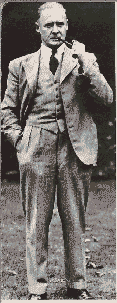 the most significant weapons of the
conflict to come - the Messerschmitt Bf 109. In the Soviet Union the
Polikarpov - 16 already existed and almost all other advanced countries
were issuing specifications for equally advanced single-seaters.
the most significant weapons of the
conflict to come - the Messerschmitt Bf 109. In the Soviet Union the
Polikarpov - 16 already existed and almost all other advanced countries
were issuing specifications for equally advanced single-seaters.
It was then, in the summer of 1934, that the British aircraft industry woke up. At the Air Ministry young Squadron Leader Ralph Sorley worked out that future fighters would need eight machine guns. And at Vickers Supermarine, Reginald Mitchell tore up his program to improve the F-7/30 Spitfire, which was already flying, and began the design of a completely new single-seat fighter, the Type 300, which would eventually also be named the Spitfire.
Mitchell had designed the S.S, S.6 and S.6B seaplanes that had won the final three Schneider Trophy races, bringing the trophy to Britain for keeps. This experience helped, but the real keys to the success of his new fighter lay in different directions.
First was his choice of powerplant. The Rolls-Royce P.V. 12, later named Merlin, prompted him to design the smallest airframe that could be accommodated around it. More important, perhaps, was his choice of wing aerofoil section, the NACA 2200. Wind-tunnel tests as early as 1927 had shown him that this section, coupled with an elliptical plan-form, would give the low drag characteristics necessary for a world-beating fighter design.
In March 1936 Mitchell's Spitfire made its first flight, from what is today Southampton airport. It was a winner from the start. Within four months the Royal Air Force had placed an initial order for 310 aircraft. At first, production was painfully slow. Supermarine had to divide their time between the Spitfire and the Stranraer and Walrus flying boats, and were designing a large bomber. Moreover the 'Spit' was difficult to make, and Britain had not yet realized they were likely to go to war.
As late as August 1938, when it entered service, many elements within the BAF were undecided about the value, and the potential, of the Spitfire. The Hawker Hurricane, superficially similar but designed along more conventional lines, being larger and of traditional technology, had beaten the Spitfire into service. It was much easier to make and to repair, and was considered by many to be superior. The Spitfire eventually answered its critics effectively.

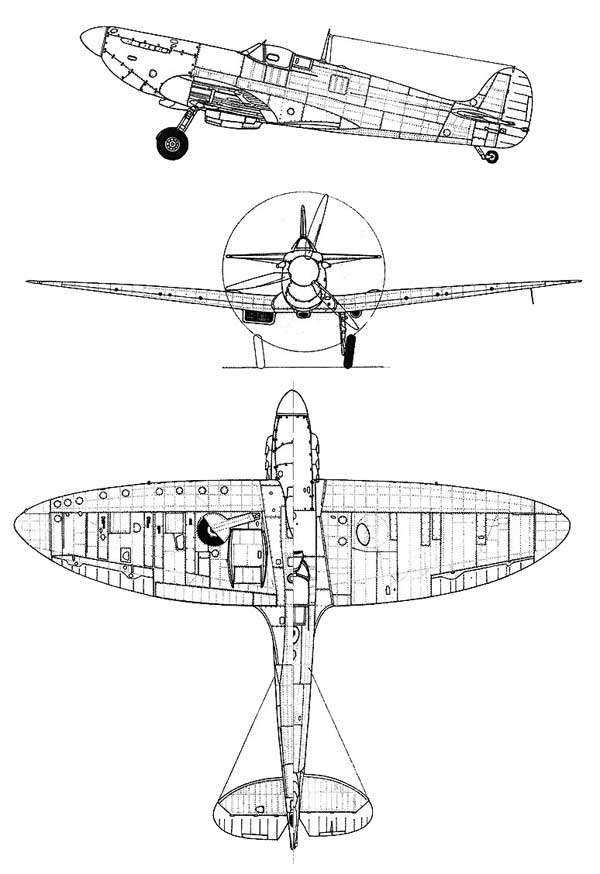 |
| Probably the most important part of this project is the three view picture of the airplane. Keep a close eye on this as you put your model together and you won't go wrong. Use a toothpick for the antenna and cut off straight pins for the guns and pilot tube. This is a great model! and does the greatness of the Spitfire justice. |
Supermarine Seafire
Obviously, there were many technical difficulties, but the feasibility or otherwise of the scheme was only to be determined by practical trials and, accordingly, having obtained the somewhat, reluctant agreement of the Air Ministry for the transfer of a number of Spitfires, both existing and to be produced, the Admiralty initiated late in 1941 preliminary trials with a Spitfire VB (AB205). An A-frame arrester hook had been introduced on the center longerons aft of the firewall and at the rear of the cockpit. His report was sufficiently encouraging to warrant Admiralty confirmation of a program covering the transfer and adaptation of 250 Spitfires for naval use. It was proposed that these would comprise 48 existing Spitfire Mk VB's with the remainder being new-production Mk VC's and as the name Sea Spitfire" was somewhat dissonant-sounding, the contraction Seafire" was officially adopted for the hooked" Spitfire. Adaptation for shipboard use was to be the essence of simplicity, and, apart from changes to internal equipment, such as the introduction of naval HE R/T and 1FF, and a homing beacon receiver, was to comprise provision of a hydraulically-damped and faired A-frame arrester hook released by means of a Bowden cable, and slinging points, with the necessary local strengthening.
We offer the Seafire as a version with the Spitfire so you get two models in one! |
The Spitfire proved, like the Bf 109, to be a very adaptable airplane, and in various versions it served throughout the war.Naturally, most of the famous British aces of WW II flew the Spitfire, including the top scoring British ace of the war Group Captain "Johnny" Johnson (38 victories), and the legless ace and hero of the Battle of Britain, Douglas Bader (he flew with two artificial legs). The Spitfire evolved from the Supermarine line of Schneider Trophy (seaplane) racers of the late1920's and early 1930's, which culminated in the trophy winning S.6B of 1931. In September of that year, the S.6B captured the Trophy with a top speed of 340.8 m.p.h., and set a world speed record of 407 m.p.h.
The prototype Spitfire was built in 1936. Like the Bf 109, and all of the other "best" fighters I will discuss, the Spitfire was an all metal stressed-skin monoplane. This was new technology at that time, and many production problems had to be solved, which resulted in considerable delays before the new fighter began reaching RAF squadrons.
The first production version was the Mk I, which entered squadron service in mid-1938. When the war came in 1939, the RAF insisted in holding the bulk of their modern monoplane fighters in Britain, sending only a few of the modern Hurricanes, and no Spitfires, to France. This proved to be a good decision as, after the fall of France, RAF fighter command could deploy about 620 Hurricanes and Spitfires to meet the Luftwaffe's 800 Bf 109s. The Luftwaffe also had about 275 Bf 110 twin engine "Destroyer" fighters, but these proved to be no match for the single engine British fighters.
The main variant of the Spitfire Mk IA was powered by the famous Rolls Royce V-12 Merlin II engine. This produced 1,230 h.p. and drove a two bladed wooden propeller, giving the early Spitfire a top level speed of about 360 m.p.h., and a best climb rate of 2,530 ft/min. By the time of the battle of Britain, a three-bladed constant speed propeller, which markedly improved climb and acceleration, had been fitted. Typical armament of both Spitfires and Hurricanes of this period was 8-.303 cal Browning machine guns, four in each wing. Some Spitfires were fitted with 2-20mm cannon plus a couple of machine guns, and these were called Mk IB's. Either way, their performance was closely similar to that of the Bf 109E, with the Spitfire being more maneuverable, and the Messerschmitt being faster in the dive, and with a higher roll rate.
In 1940 the Mk II began to appear, and replaced the Mk I in early 1941. The Mk II was powered by a1,240 h.p. Merlin XII, which gave it a top speed almost identical to the Mk I (354 m.p.h. at 17,550 ft), but a higher rate of climb (3,025 ft/min). It is worth mentioning that all Spitfire versions had carburetors, not fuel injection, and the engines would quit for lack of fuel if the aircraft was flown upside down. Mk II's were also armed with either eight machine guns, or a mix of machine guns and cannons. All Spitfires of this period had the signature elliptical plan wings, and were (in my opinion) among the most graceful of all fighter planes.
History records that these Spitfires (and Hurricanes) prevailed in the Battle of Britain. Their primary shortcoming, again like the Bf 109, was their short range. This was not a problem while they were serving in the interceptor role during the Battle of Britain, but it became a glaring fault when the RAF went over onto the offensive. Later marks of Spitfire included the Mk V of 1941, which for the first time introduced "clipped" wing tips to increase the roll rate. The Mk V had a top speed of up to 374 m.p.h., but had begun to fall behind the Bf 109F in overall performance, a problem that intensified when the Germans introduced the FW 190 fighter (see following section). Best rate of climb was 2,900 ft/min. The Mk V probably represents the low point of the Spitfire v. s. the top German fighters.
The next big production model was the Mk IX, a Mk V airframe with a new two stage, two speed, supercharged Merlin 70 engine, which developed 1,655 h.p. at 10,000 ft. This new engine was really intended for the all new Spitfire Mk VIII airframe, but the press of events forced its adoption in the older airframe. The result, however, was quite satisfactory. Top speed was raised to 415 m.p.h. at 27,800 ft. Best climb rate jumped to 4,530 ft/min. The Mk IX started to enter service around the middle of 1942, and proved able to meet the German fighters on an essentially equal footing. The elliptical wing plan returned in the Mk IX, which was approximately contemporary to the Bf 109G, and like that fighter, served for the rest of the war.
The Mk VIII finally came along in 1943, incorporating many detail improvements, including better streamlining and a fully retractable tail wheel. Best climb rate was 3,790 ft/min. This version was used mostly in the Far East, later in the war. The final major models were the Mk XIV of 1944, and the Mk 22 of 1945.
The Mk XIV was a Mk VIII airframe with a Rolls Royce Griffon engine, developing 2,035 h.p., good for a top speed at altitude of 439 m.p.h. It drove a five bladed propeller and gave the Mk XIV an improved service ceiling and enhanced high altitude performance, to match the latest German fighters. Best climb rate was up to 4,700 ft/min. Later Mk XIV's also had a "teardrop" style canopy to improve all-around visibility.
The Mk 22 was the last Spitfire, also with a teardrop canopy, and for the first time the wing was redesigned. The new wing was similar in plan, but was stronger, carried more fuel, housed a longer landing gear (which allowed a larger diameter propeller), and carried four 20mm cannon. Speed was up to 450 m.p.h., and best climb rate up to 4,900 ft/min. The Spitfire had reached the end of its long career. The future would belong to more modern fighters, but by this time the war was ending anyway, and the jet age had begun.
The changing shape of the Spitfire; not only did the engines become more powerful, but the canopy was improved to better all-round visibility and a whip antenna replaced the earlier mast. Four of the eight machine guns were replaced by two cannon and aircraft were given underwing points to take bombs or rockets. Despite all these changes the aircraft remained a Spitfire, and one of the best fighters of World War II.
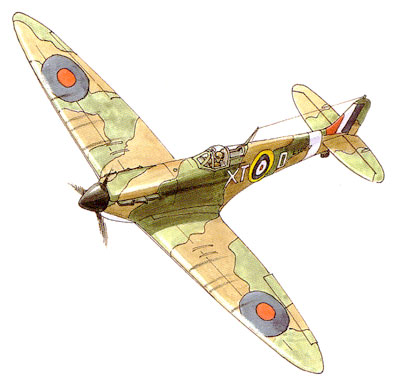
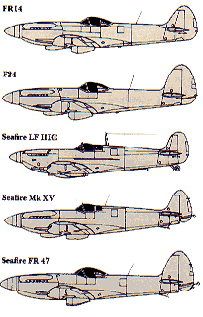 |
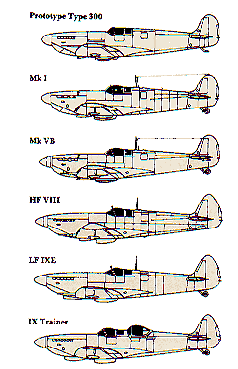 |
The changing shape of the Spitfire; Not only did the engines become more
powerful, but the canopy was improved to better all-round visibility and
a whip antenna replaced the earlier mast. Four of the eight machine guns
were replaced by two cannon and aircraft were given underwing points to
take bombs or rockets. Despite all these changes the aircraft remained a
Spitfire, and one of the best fighters of World War II. |
|
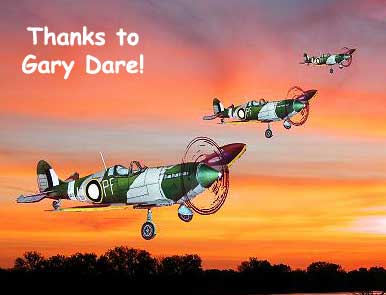
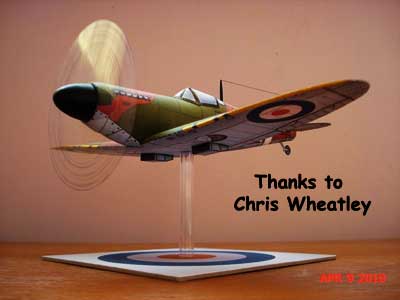
Specifications for the Supermarine Spitfire
 |
Length: 29 ft 11 in
|
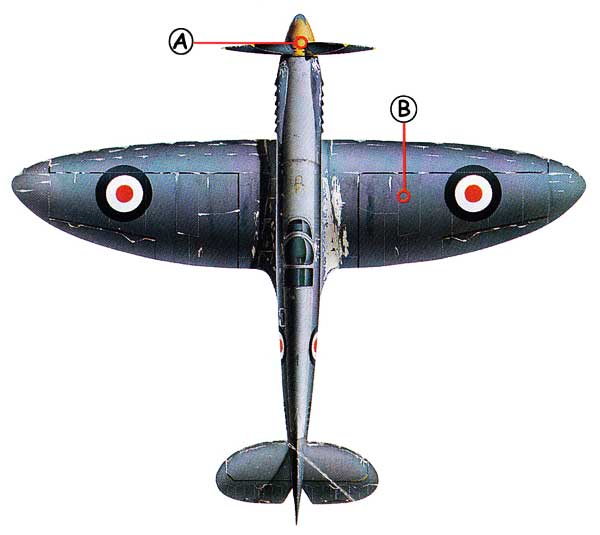 |
|
| A: A five-blade propeller was introduced on the Mk XIV to take advantage of the Griffon's increased power. | B: The elliptical wing shape of the Spitfire remained essentially unchanged from 1936 until 1944. |
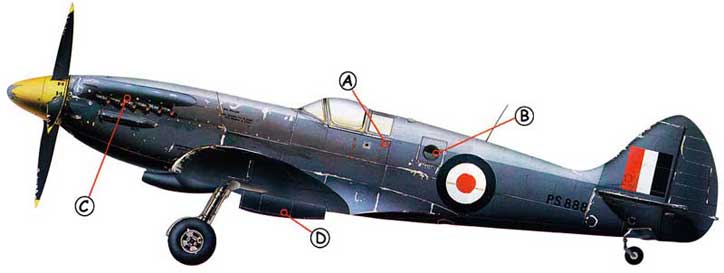 |
|||
| A: Most Mark XIXs had a pressurized cockpit for service at the high altitudes common on reconnaissance sorties. Behind the cockpit on the port side is one of the camera ports. | B: PR.Mk XIXs replaced the Merlin-engined Mk XI as the RAF's standard single-engine reconnaissance type. They were unarmed and fitted with vertical and oblique cameras aft of the cockpit. | C: Distinctive bumps on the nose cowling over the cylinder banks distinguish Griffon-engine Spitfires from earlier marks. Also, the Griffon and its propeller turn in the opposite direction from the Merlin. | D: Large intakes under the wings of the Mk XIX are for the engine's radiator. The smaller intake under the nose is for the oil cooler, while the scoop on the engine cowl feeds the cabin pressurization system. |
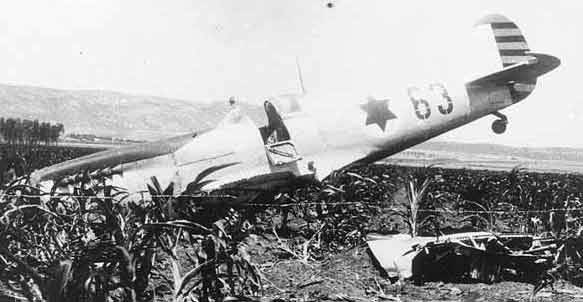
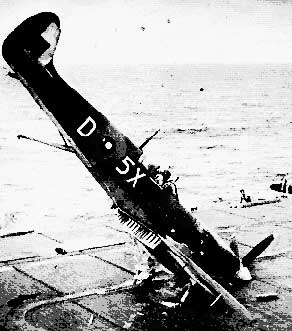



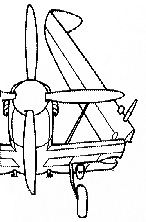 The Seafire, certainly aesthetically the most elegant fighter ever
to grace a carrier deck, was the product of adversity; it might be
said to have been born of desperation. The role of naval air power
was expanding with the course of the war, but its full potential could
not be exploited without a shipboard fighter capable of a performance
at least comparable with contemporary enemy shore-based fighters by
which it was likely to be opposed. In so far as the Royal Navy was
concerned, the
The Seafire, certainly aesthetically the most elegant fighter ever
to grace a carrier deck, was the product of adversity; it might be
said to have been born of desperation. The role of naval air power
was expanding with the course of the war, but its full potential could
not be exploited without a shipboard fighter capable of a performance
at least comparable with contemporary enemy shore-based fighters by
which it was likely to be opposed. In so far as the Royal Navy was
concerned, the 